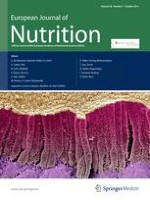Published in:

01-10-2011 | Original Contribution
Plasma pharmacokinetics of catechin metabolite 4′-O-Me-EGC in healthy humans
Authors:
Mathieu Renouf, Karine Redeuil, Karin Longet, Cynthia Marmet, Fabiola Dionisi, Martin Kussmann, Gary Williamson, Kornél Nagy
Published in:
European Journal of Nutrition
|
Issue 7/2011
Login to get access
Abstract
Background
Tea is an infusion of the leaves of the Camellia sinensis plant and is the most widely consumed beverage in the world after water. Green tea contains significant amounts of polyphenol catechins and represents a promising dietary component to maintain health and well-being. Epidemiological studies indicate that polyphenol intake may have potential health benefits, such as, reducing the incidence of coronary heart disease, diabetes and cancer. While bioavailability of green tea bioactives is fairly well understood, some gaps still remain to be filled, especially the identification and quantification of conjugated metabolites in plasma, such as, sulphated, glucuronidated or methylated compounds.
Aim of the study
In the present study, we aimed to quantify the appearance of green tea catechins in plasma with particular emphasis on their methylated forms.
Results
After feeding 400 mL of green tea, 1.25% infusion to 9 healthy subjects, we found significant amounts of EC, EGC and EGCg in plasma as expected. EGC was the most bioavailable catechin, and its methylated form (4′-O-Me-EGC) was also present in quantifiable amounts. Its kinetics followed that of its parent compound. However, the relative amount of the methylated form of EGC was lower than that of the parent compound, an important aspect which, in the literature, has been controversial so far. The quantitative results presented in our study were confirmed by co-chromatography and accurate mass analysis of the respective standards. We show that the relative abundance of 4′-O-Me-EGC is ~40% compared to the parent EGC.
Conclusion
4′-O-Me-EGC is an important metabolite derived from catechin metabolism. Its presence in significant amounts should not be overlooked when assessing human bioavailability of green tea.